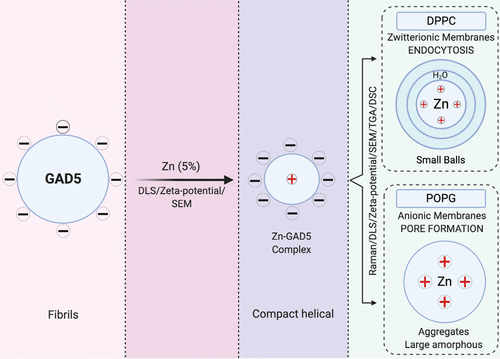Our official English website, www.x-mol.net, welcomes your feedback! (Note: you will need to create a separate account there.)
Interactions of an Anionic Antimicrobial Peptide with Zinc(II): Application to Bacterial Mimetic Membranes
Langmuir ( IF 3.9 ) Pub Date : 2020-11-23 , DOI: 10.1021/acs.langmuir.0c02306 Bashiyar Almarwani 1 , Nsoki Phambu 1 , Yahia Z Hamada 2 , Anderson Sunda-Meya 3
Langmuir ( IF 3.9 ) Pub Date : 2020-11-23 , DOI: 10.1021/acs.langmuir.0c02306 Bashiyar Almarwani 1 , Nsoki Phambu 1 , Yahia Z Hamada 2 , Anderson Sunda-Meya 3
Affiliation

|
While the majority of known antimicrobial peptides are cationic, a small number consist of short Asp-rich sequences that are anionic. These require metal ions to become biologically active. Here, we report the study of the zinc complexes of the peptide GADDDDD (GAD5), an antimicrobial peptide. Using a combination of dynamic light scattering (DLS), ζ-potential, infrared, Raman, thermogravimetric analysis (TGA), differential scanning calorimetry (DSC), and scanning electron microscopy (SEM), we find that adding zinc ions to GAD5 forces it into a compact structure. Higher amounts of zinc ions favor a larger structure, possibly a dimer. SEM images show that zinc ions reduce the size of the fibrillar structures of GAD5. TGA curves show that the addition of zinc ions increases the thermal stability of the structure of the peptide. TGA and DSC indicate that the association of GAD5 with a zwitterionic phospholipid in the presence of zinc ions is the most stable. The stability of that complex is due to the presence of a sharp endothermic peak in the 200–300 °C range, suggesting the presence of interlamellar water that is essential to the stabilization of the structure. These results indicate that the Zn–GAD5 complex prefers the bacteria-mimicking neutral (zwitterionic) membranes. In the presence of negatively charged phospholipids, the complex remains unordered and unstable. In terms of mechanism of action, the Zn–GAD5 complex promotes a possible endocytic uptake with respect to neutral (zwitterionic) membranes while promoting membrane disruption by forming pores with respect to negatively charged phospholipids.
中文翻译:

阴离子抗菌肽与锌 (II) 的相互作用:在细菌模拟膜中的应用
虽然大多数已知的抗微生物肽是阳离子的,但少数由阴离子的富含 Asp 的短序列组成。这些需要金属离子变得具有生物活性。在这里,我们报告了肽 GADDDDD (GAD5) 的锌复合物的研究,这是一种抗菌肽。结合使用动态光散射 (DLS)、ζ 电位、红外、拉曼、热重分析 (TGA)、差示扫描量热法 (DSC) 和扫描电子显微镜 (SEM),我们发现向 GAD5 添加锌离子会强制它成一个紧凑的结构。较高量的锌离子有利于较大的结构,可能是二聚体。SEM 图像显示锌离子减小了 GAD5 的纤维状结构的大小。TGA曲线表明锌离子的加入增加了肽结构的热稳定性。TGA 和 DSC 表明 GAD5 与两性离子磷脂在锌离子存在下的结合是最稳定的。该复合物的稳定性是由于在 200-300 °C 范围内存在一个尖锐的吸热峰,这表明存在对结构稳定至关重要的层间水。这些结果表明 Zn-GAD5 复合物更喜欢模拟细菌的中性(两性离子)膜。在带负电荷的磷脂存在下,复合物保持无序和不稳定。就作用机制而言,Zn-GAD5 复合物促进可能的对中性(两性离子)膜的内吞摄取,同时通过形成与带负电荷的磷脂有关的孔来促进膜破坏。
更新日期:2020-12-08
中文翻译:

阴离子抗菌肽与锌 (II) 的相互作用:在细菌模拟膜中的应用
虽然大多数已知的抗微生物肽是阳离子的,但少数由阴离子的富含 Asp 的短序列组成。这些需要金属离子变得具有生物活性。在这里,我们报告了肽 GADDDDD (GAD5) 的锌复合物的研究,这是一种抗菌肽。结合使用动态光散射 (DLS)、ζ 电位、红外、拉曼、热重分析 (TGA)、差示扫描量热法 (DSC) 和扫描电子显微镜 (SEM),我们发现向 GAD5 添加锌离子会强制它成一个紧凑的结构。较高量的锌离子有利于较大的结构,可能是二聚体。SEM 图像显示锌离子减小了 GAD5 的纤维状结构的大小。TGA曲线表明锌离子的加入增加了肽结构的热稳定性。TGA 和 DSC 表明 GAD5 与两性离子磷脂在锌离子存在下的结合是最稳定的。该复合物的稳定性是由于在 200-300 °C 范围内存在一个尖锐的吸热峰,这表明存在对结构稳定至关重要的层间水。这些结果表明 Zn-GAD5 复合物更喜欢模拟细菌的中性(两性离子)膜。在带负电荷的磷脂存在下,复合物保持无序和不稳定。就作用机制而言,Zn-GAD5 复合物促进可能的对中性(两性离子)膜的内吞摄取,同时通过形成与带负电荷的磷脂有关的孔来促进膜破坏。



























 京公网安备 11010802027423号
京公网安备 11010802027423号